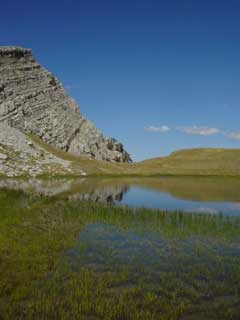 Fountains of Life Found at the Bottom of the Dead Sea
Fountains of Life Found at the Bottom of the Dead Sea
The planet is kind of amazing sometimes. Researchers have discovered plumes of fresh water at the bottom of the Dead Sea, deeper than any previous plumes that had been found. And around the plumes: life. Even though most microbes that live in salt die in fresh water and vice versa, some tough little buggers are hanging on in a space where salinity shifts constantly.
The Dead Sea is the lowest point on earth, and getting lower every year, as water that would ordinarily fill it by flowing in from the Jordan River has been diverted to quench the thirst of Israel, Jordan, and Palestine. Every year, the lake drops over a meter per year. If this goes on long enough, the Sea could face Owens Lake’s and the Aral Sea’s fate: becoming a wind-swept salt flat. Yet, for now, life goes on.
Biologists have known since the 1930s the lake is “not dead yet”. Instead, it’s full of microbes that get along quite happily in the salty soup, for it keeps out competitors that would take over in a more hospital aqueous environment. In general, the water contains 1,000 to 10,000 archaea* per ml, a much lower concentration of life than in seawater, but quite respectable, all in all, for a place where one molecule in three is not water. Occasionally, when conditions are right, the sea blooms red with life. This happened in 1980 and 1992.
These are freshwater springs, jetting into the bottom of the Dead Sea from inside craters. Found as deep as 100 feet from the surface, the springs lie at the base of craters as large as 50 feet wide and 65 feet deep. As can be seen, a variety of interesting geological formations surround them.
The springs roil the waters they flow into in a phantasmal slipstream. Starting at about 2:00, you can see it coiling and mixing like it’s hundreds of degrees hotter or more sugary than the surrounding water. But no, it’s just that much less salty (and dense). (There’s a famous scene in the “Caves” episode of Planet Earth that vividly illustrates salinity gradients (haloclines) in the cenotes of Mexico too — go track down a copy if you can).
What makes this place biologically amazing was the life they found near the plumes.
--
Rivers and streams—most notably the Jordan River—once regularly infused fresh water into the Dead Sea.
The basin has no outlet, so water escapes only by evaporation. As fresh water evaporates, salty minerals dissolved in the water get left behind. Over time, this process made the Dead Sea much saltier than ocean water.
The lake's saltiness means that larger organisms such as fish and frogs can't survive in the Dead Sea. But a high concentration of magnesium also makes it surprising to find microbes in the lake.
"There are other hypersaline environments that are full of microbial life," Ionescu noted. "This, in my opinion, makes our discovery even more surprising."
In the 1950s countries in the Middle East, including Jordan and Israel, cut off the Jordan River's supply to the Dead Sea to gain drinking water. The move severely lowered the lake's water level—a loss that continues by up to a meter (four feet) a year, according to the research team.
Water in the lake, which already sits in the lowest place on Earth, has fallen by more than 80 feet (25 meters) in the past 40 years.
(See "Diverting Red Sea to Save Dead Sea Could Create Environmental Crisis.")
Few biologists have studied the water body in recent years, except following two major algae bloom events that colored the Dead Sea red in 1980 and 1992.
The surface blooms were caused by organisms different than those recently discovered at depth, Ionescu noted.
In general, the "study really changes how we see the Dead Sea, from a biological perspective," said Kelly Bidle, an environmental microbiologist at Rider University in New Jersey who studies bacteria that live in salty habitats.
That's because "seeing this diversity in a place we had never thought was there before" is very exciting, she said.
"Impressive" Craters Unique to Dead Sea
The 2010 expedition mapped an "impressive" network of about 30 craters, a landscape that has no parallel elsewhere on Earth, said team leader Ionescu, whose research is soon being submitted for publication. (Get more information about the research.)
Preliminary analyses of samples collected in the craters suggest that the springs' bacterial communities are very diverse—akin to what you'd find living on rocks in a regular saltwater sea, he added.
The top of the springs' rocks are covered with green biofilms, which use both sunlight and sulfide—naturally occurring chemicals from the springs—to survive. Exclusively sulfide-eating bacteria coat the bottoms of the rocks in a white biofilm. (See marine-microbe pictures.)
Not only have the organisms evolved in such a harsh environment, Ionescu speculates that the bacteria can somehow cope with sudden fluxes in fresh water and saltwater that naturally occur as water currents shift around the springs.
The existence of such adaptable bacteria is an "intriguing" idea that needs more research, Rider University's Bidle said.
As of right now, "there is no such documented species that exists that could fit this bill"—all highly salt-adapted bacteria die when placed in fresh water, and vice versa, she noted.
If "your machinery is wired for high salt, it's very difficult to imagine that you could go from an extreme amount of salt to near-freshwater biology."
Even so, Bidle doesn't totally rule out the idea: "When it comes to inhabiting extreme environments, nothing surprises me when it comes to microbial life," she said.
Dead Sea Diving Not for Everyone
Ionescu and colleagues will visit the underwater craters again in October to study more about the behaviors and life cycles of the newfound bacteria.
It's no easy task—each diver has to carry 90 pounds (40 kilograms) of weight to lower his or her buoyancy, since the sea's high salt content tends to make people float.
Divers will also need to wear full face masks to protect their eyes and mouths. That's because accidentally swallowing Dead Sea salt water would cause the larynx to inflate, resulting in immediate choking and suffocation.
Likewise, the intensely salty water would instantly burn and likely blind the eyes—both reasons why Dead Sea swimmers rarely fully submerge their bodies, Ionescu noted.
"It's a very unique experience," Ionescu said of diving in the Dead Sea, but "I wouldn't recommend it for recreational diving."
| Contact information | n/a |
|---|---|
| News type | Inbrief |
| File link |
http://blogs.scientificamerican.com/artful-amoeba/2011/10/09/fountains-of-life-found-at-the-bottom-of-the-dead-sea/ |
| Source of information | http://www.slate.fr/lien/44837/source-eau-douce-mer-morte |
| Subject(s) | HYDRAULICS - HYDROLOGY , NATURAL MEDIUM , WATER QUALITY |
| Relation | http://news.nationalgeographic.com/news/2011/09/110928-new-life-dead-sea-bacteria-underwater-craters-science/ |
| Geographical coverage | Palestine,Israel,Germany,Jordan, |
| News date | 11/10/2011 |
| Working language(s) | FRENCH |
 you are not logged in
you are not logged in





